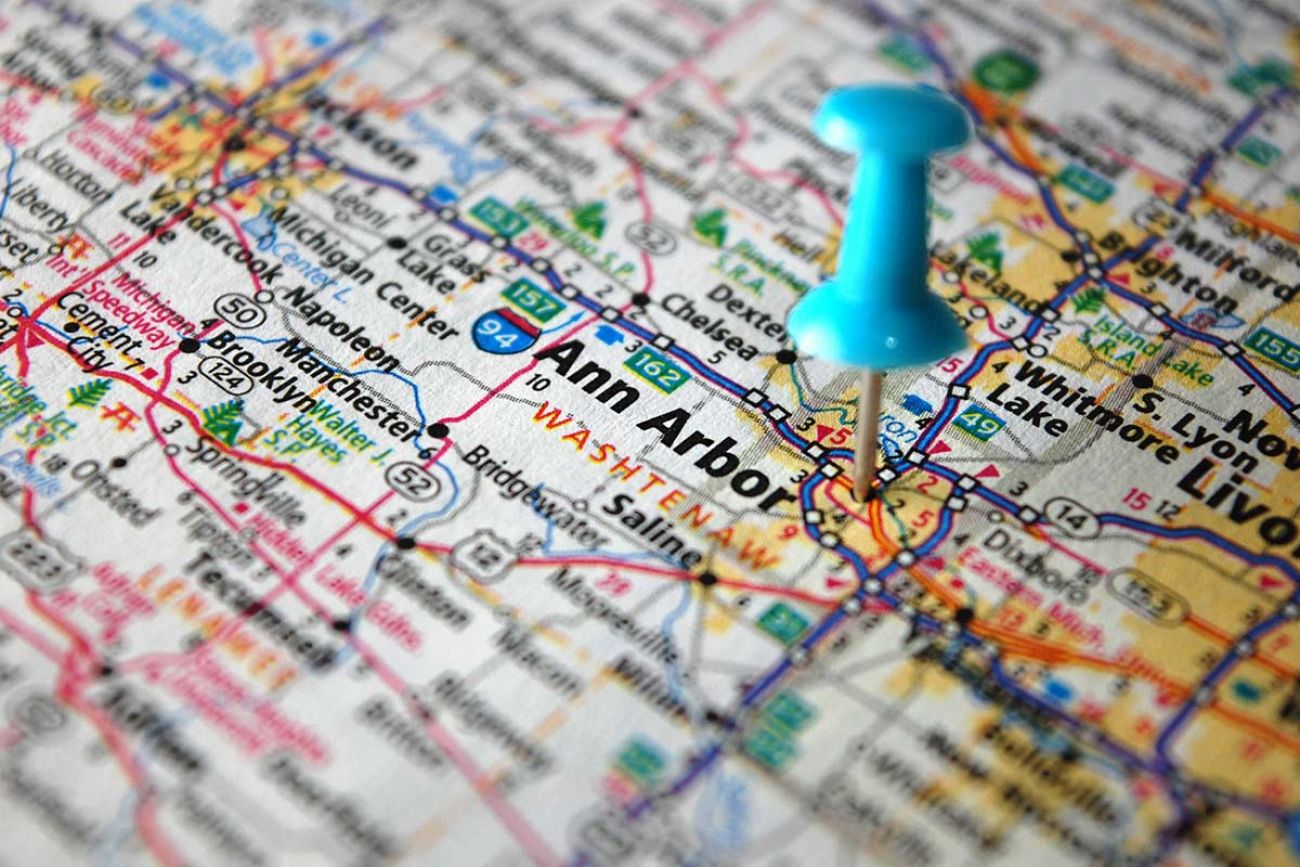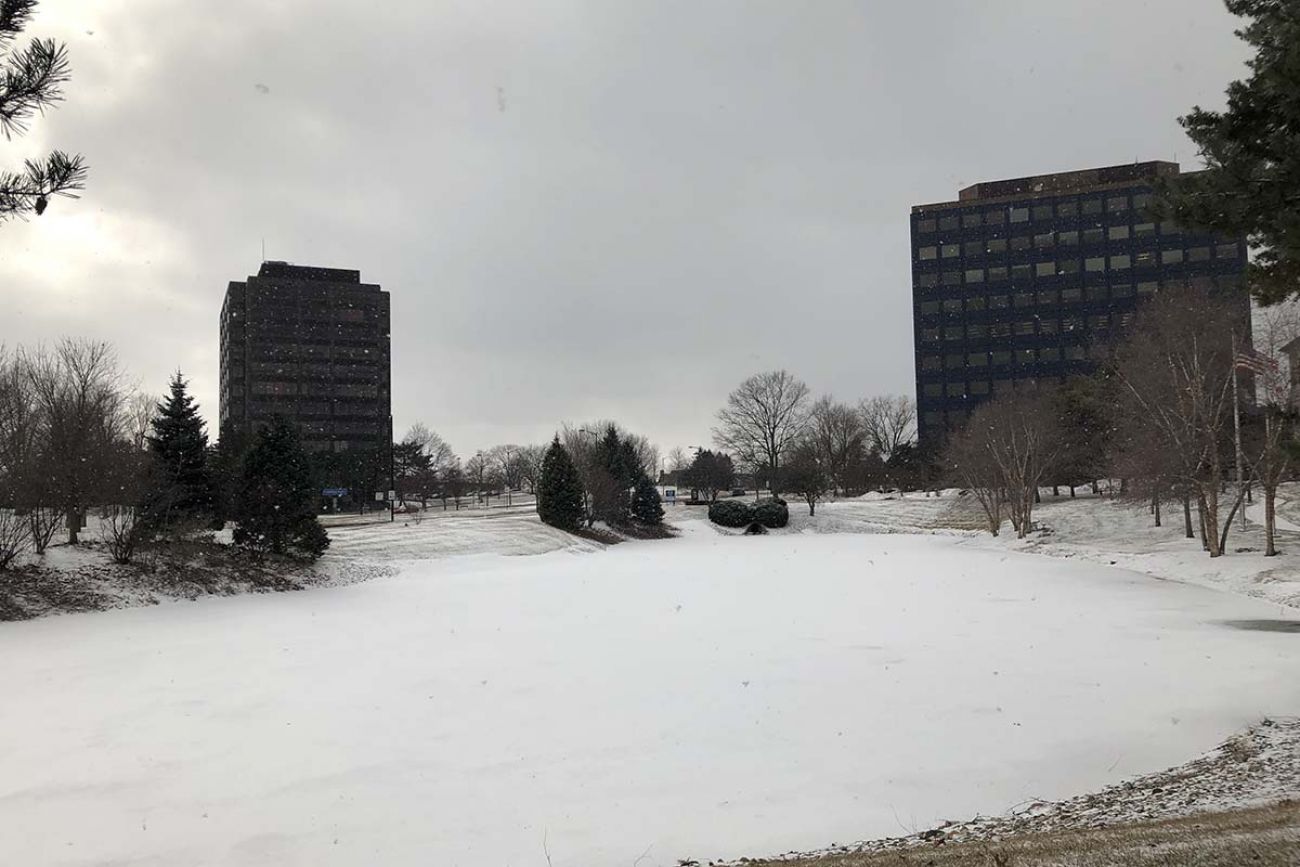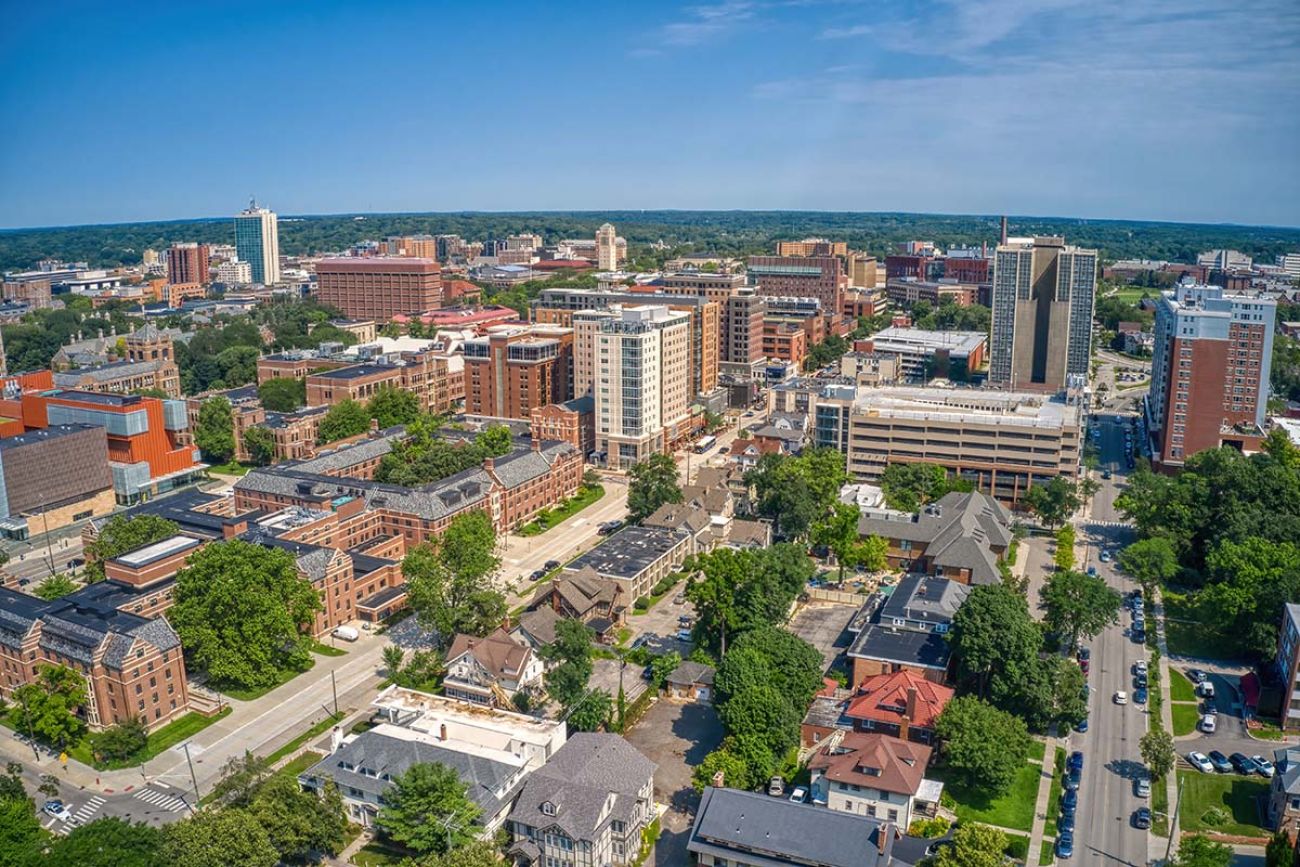Ann Arbor wants more housing and fewer cars. Is 'unzoning' the answer?

ANN ARBOR—More than 80,000 commuters enter this college town daily for work, just one sign of the vitality found in Michigan’s fifth largest city.
The influx represents two-thirds of the number of people already living in Ann Arbor, a situation that leaves traffic abundant and underscores what city leaders see as a lack of adequate housing in the city.
But officials think they’ve found a way to solve both problems. And they’re looking at the area around Briarwood Mall, in a commercial area about three miles south of the University of Michigan’s central campus.

After revising the city’s land-use regulations last summer with a plan to increase building density and encourage new housing in highly-traveled corridors of the city, the city council is expected to vote this spring to essentially remove typical zoning restrictions on 68 properties around the mall, in what it calls the city’s first “Transit Corridor District.” More are likely to follow.
Related:
- Ann Arbor pours money into green affordable housing. Will others follow?
- Updating Michigan energy rules on new homes faces pushback from builders
The idea is to encourage the kind of dense, mixed development more typical in a downtown. While many popular cities in the state like Traverse City, Birmingham and Grand Rapids are increasing walkability with more housing downtown, Ann Arbor’s proposal attempts a similar focus outside of the central business district.
Under the plan, developers will be able to build “downtown style” on the edge of the city. There will be no minimum number of parking spaces, no required “setback” of undeveloped space between the lot line and the building, and an encouragement of tall buildings filled with apartments or condominiums — up to 29 floors, depending on how close property is to an existing neighborhood, replacing the two-story limit currently in effect.
Moreover, property owners will be allowed to build new construction within the “dead zones” of unused land around an existing building, or even demolish one and start over.
And the typical buildings allowed outside of downtown will be prohibited: The new zoning will only allow buildings of two or more stories — while prohibiting a single-family house, duplex, gas station or anything with a drive-through.
The 226-acre area targeted for the proposal is a regional employment hub, said Sarah Mills, chair of the city’s planning commission and a project manager in the University of Michigan Gerald R. Ford School of Public Policy.

By adding housing to the mix, Mills said, it could thrive by being more than than a sprawling commercial area where people drive in and drive out for work or shopping.
“We would get ‘neighborhoody’ feelings around the kind of mix of uses that we see downtown,” Mills said.
The Ann Arbor “unzoning” proposal is unique in Michigan, even as the concept is growing in other communities around the country, said Carolyn Ulstad, manager of transportation and community design for Groundwork Center for Resilient Communities, a nonprofit based in Traverse City that advocates for sustainable land use.
One aspect is untying driving patterns from development, which is starting to happen in Traverse City, like Ann Arbor, a growing area of Michigan. So-called parking reform has been enacted in New York City; Minneapolis, Nashville, Cincinnati and several towns in Oregon, and it’s been debated in Los Angeles. Most places limited it to downtown or transit corridors, where residents may not need to own an automobile.
Another goal is to trim costs from development to encourage more housing construction. Limiting residential housing in an area limits a property’s profit-making potential, developers say; building parking also adds money to a project. Removing both barriers could, proponents say, reduce building costs in a city that’s hurting for middle- and lower-income housing.
“Housing is in short supply virtually everywhere,” Ulstad said. “For a place like Ann Arbor that already is an economic hub, they already know they have the demand.

“They just need to provide the environment for the supply.”
City officials discussed the transit corridor concept for years before council approved it in July. Then last fall, city staff targeted the South State Street area just north of I-94 for the first block of blanket rezoning under the new guidelines, affecting the properties of a range of sizes.
If the zoning change is approved, it’s up to the property owners to figure out what could work.
These changes, said Mills of the city planning commission, are the building blocks for a city that wants to create more space for the people who want to be there, while setting it up to become less auto-dependent if that’s the direction property owners want to take.
“The zoning only sets the rules for it,” she said. “It relies on private development to come in and do it.”
Remaking a gateway
Development in downtown Ann Arbor took off nearly 20 years ago as the city revised land use rules to allow taller buildings. The goal then was to increase the number of residents.
Fast-forward to 2022 after thousands of people moved into new apartments and condos, and high-rises are still breaking ground downtown and around the U-M campus. Among the latest are a 13-story student apartment building on South University and a 19-story apartment building adjacent to the Michigan Theater.
But a couple of miles south on State Street, the southern gateway to the University of Michigan campus shares little with downtown. It has been a regional retail and office hub for Ann Arbor since Briarwood Mall was built north of the I-94 interchange in the 1970s.

It’s still the anchor to the city’s largest office market, which totals 3.3 million square feet and stretches from the landmark office tower long-called the “777 Building” south across I-94 and into Pittsfield Township toward the Avis Farms office park.
Most of the property surrounding the mall are single-use buildings: one-story chain restaurants, hotels with banquet centers and Class A office space that house law, accounting and real estate offices. The University of Michigan is both an owner and dominant tenant for the offices.
In most cases, the buildings have plenty of asphalt around them. Those parking lots — often paired with open expanses of lawn — offer the most obvious places where new construction could be added.
Cities used to make sure that developers added “plenty of parking” to their office or retail plans, said Greg Copp, vice president of development and construction for MAV Development, which owns the South State Commons office buildings on the southern end of the proposed transit corridor district.
“Now we have to fight for parking,” he said.
Bus routes operated by the Ann Arbor Area Transportation Authority remain the only mass transit in the area, said Jeff Harshe, vice president and chief operating officer at MAV. Until significant new construction that adds population density happens, route expansion isn’t likely, he said. At the same time, proximity to I-94 means residents would have easy access to a major commuting route to Detroit and other areas.
So the first few developers in the new district are likely to be designing space for residents to have what proponents hope they won’t need: Cars.
Otherwise, Harshe said, “How do you get where you want to go?”
Mills said that the city envisions parking spots being shared as more building uses come to the area to fit a range of lifestyles: Housing, groceries and nightlife all would complement the 9-to-5 office and retail spaces, and possibly inspire more transit options.
Plus, she said, studies show that Ann Arbor “is less car dependent than a lot of places in Michigan, and this is a step to make us (more so). “
Even as stores close at the mall, requiring fewer parking spaces surrounding it, Briarwood isn’t part of the plan to rezone the properties around it. City planner Alexis DiLeo told residents at a meeting last fall the mall deserves its own planning effort and “ideally it will play nicely together” if changes around the mall are approved.
And here’s a twist: Adding housing around the mall could increase its viability in the future, said Luke Bonner, CEO of Bonner Advisory Group, a real estate and economic development consulting firm that is based in the city and works around the U.S.
Solving land use around malls “is really a nationwide problem,” Copp added.
While building 29 stories could be alluring for a developer who sees several newer high-rises valued at $40 million and more downtown, there are no comparables for how similar buildings without parking would fare around Briarwood, said Harshe of MAV Development. That could make financing tough until some smaller projects are built.
At least one property owner, Oxford Companies, told MLive.com that it’s considering adding apartments to underused parking at 777 Eisenhower Parkway, which it purchased in 2018 for $29.5 million.
Yet, as the new TC1 plans move to council, the planning commission also will be evaluating a new site plan for one of those single-story properties: The former Macaroni Grill restaurant could become a slightly smaller Outback Steakhouse, surrounded by 148 parking spaces.
Despite the city’s sustainability goals to reduce car trips and ownership, Andy LaBarre, vice president of government affairs for the Ann Arbor/Ypsilanti Area Chamber of Commerce and a Washtenaw County commissioner, agrees with Harshe that transportation may still play a role in slowing changes if the zoning is approved.
“People are more plugged into how design incorporates a car-centric society and how that’s evolving and changing,” LaBarre told Bridge Michigan.
However, while many areas in the U.S. are changing the framework for how cities function with fewer autos, this remains a transition period, he added.
At first, at least, “my hunch is that any new development will have to bring increased traffic and it will have to be managed like in every other part of the city,” LaBarre said.
Can it work?
Supporters of “unzoning” include many of the affected property owners, including MAV Development, and people who say it will accomplish the goal of adding mass transit options and housing.
Skeptics say the change will increase the value of the affected property without ensuring specific benefits to the city, namely additional affordable housing units.
Land costs already are a barrier to development in Ann Arbor, said Bonner. That isn’t likely to change around a commercial center like Briarwood.
“Zoning is obviously important, but so is the ability to negotiate and acquire parcels reasonably. And overall in Ann Arbor, properties are not reasonably (priced) anywhere in the city,” Bonner said.
That may not change around South State if new zoning is approved. Allowing more density typically increases what property is worth, Harshe said. By building more, a developer can sell or lease more. That’s prompted debate within the city council about whether the new rules enrich this group of landowners over others in the city.
In addition, the lack of required parking could change financing for a new development, Copp said. That, in turn, could affect the number of residential units — and their eventual price, either for sale or rent.
Navigating development options may leave little room for affordable housing, even as the city continues to recognize the need for it. It planned nearly 3,000 new units for lower income residents in 2015; by 2021, as the city approved an affordable housing millage, it hadn’t met that pace of construction yet.
And the Ann Arbor housing market is getting less affordable. The median sale prices for single-family homes have climbed three straight years, reaching $336,150 in January. The number of available homes dropped by half at the start of this year, suggesting further increases ahead as competition to buy heats up.
Rental rates also are increasing, as new construction targets the student and luxury markets. The average apartment in the city now costs $1,749 per month, according to Rentcafe, while just 7 percent of rentals are priced at $1,000 per month or less.
Moving developer attention away from very high land costs downtown to the Briarwood area “doesn’t mean new affordable housing options are waiting in the wings,” Bonner said. “You still need to factor the cost of construction being so high, and in order to sustain that cost you need higher rents.
“The only way affordable housing will truly become an option is if the city specifically mandates it and is also willing to support it financially,” Bonner said. “Otherwise, the 226 acres of rezoned properties around the mall will also become high-end luxury residential developments.”
City Council will discuss the proposal on March 7, with a vote likely before the end of the month. No timing has yet been decided for when the “unzoning” could be proposed for other areas of the city, including Washtenaw Avenue near US 23.
While this proposal could reshape a portion of Ann Arbor, there's an implication for the rest of the state if there’s a sizable increase in housing units, said Ulstad of Greenwork. Other areas may be watching Ann Arbor to see if that happens.
Zoning laws, she said, can ensure that housing will remain unaffordable for much of the population if they mandate single family homes. That won’t work for communities that are attracting new businesses who are seeking workers.
Allowing taller buildings and mandating mixed-uses could give growing areas like Grand Rapids, Traverse City and Ottawa County on the Lake Michigan shore options for the future.
“It’s about keeping Michigan competitive,” Ulstad said. “If you want to grow and attract people, it’s just necessary to allow new housing types.”
Business Watch
Covering the intersection of business and policy, and informing Michigan employers and workers on the long road back from coronavirus.
- About Business Watch
- Subscribe
- Share tips and questions with Bridge Business Editor Paula Gardner
Thanks to our Business Watch sponsors.
Support Bridge's nonprofit civic journalism. Donate today.
See what new members are saying about why they donated to Bridge Michigan:
- “In order for this information to be accurate and unbiased it must be underwritten by its readers, not by special interests.” - Larry S.
- “Not many other media sources report on the topics Bridge does.” - Susan B.
- “Your journalism is outstanding and rare these days.” - Mark S.
If you want to ensure the future of nonpartisan, nonprofit Michigan journalism, please become a member today. You, too, will be asked why you donated and maybe we'll feature your quote next time!




